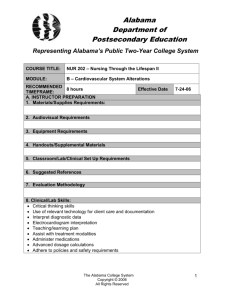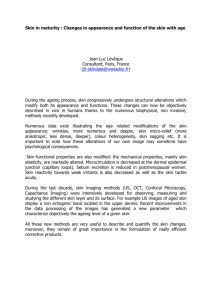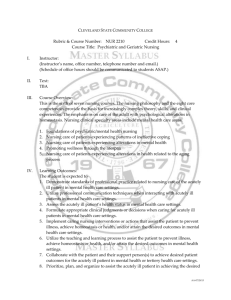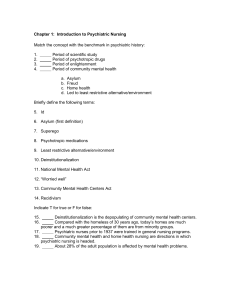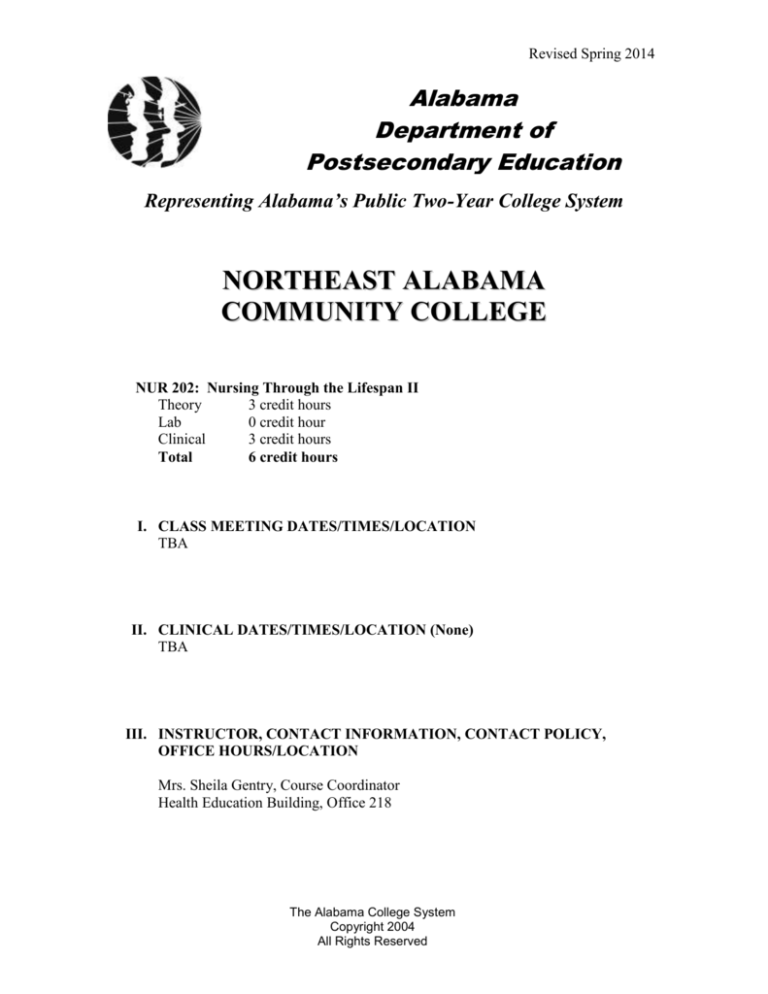
Revised Spring 2014
Alabama
Department of
Postsecondary Education
Representing Alabama’s Public Two-Year College System
NORTHEAST ALABAMA
COMMUNITY COLLEGE
NUR 202: Nursing Through the Lifespan II
Theory
3 credit hours
Lab
0 credit hour
Clinical
3 credit hours
Total
6 credit hours
I. CLASS MEETING DATES/TIMES/LOCATION
TBA
II. CLINICAL DATES/TIMES/LOCATION (None)
TBA
III. INSTRUCTOR, CONTACT INFORMATION, CONTACT POLICY,
OFFICE HOURS/LOCATION
Mrs. Sheila Gentry, Course Coordinator
Health Education Building, Office 218
The Alabama College System
Copyright 2004
All Rights Reserved
Nursing Through the Lifespan II
V.
VI.
NUR 202
COURSE DESCRIPTION:
This course builds upon previous instruction and provides additional
opportunities to develop competencies necessary to meet the needs of individuals
throughout the lifespan in a safe, legal, and ethical manner using the nursing
process. Students manage and provide collaborative care to clients who are
experiencing selected alterations in cardiovascular, hematologic, immune, and
genitourinary systems in a variety of settings. Additional instruction is provided
for psychiatric disorders, and high-risk obstetrics. Teaching/learning concepts,
advanced dosage calculations, nutrition, pharmacology, communication, cultural,
and community concepts are integrated. This course supports CIP code 51.1601.
PREREQUISITE(S)/CO-REQUISITE(S)
PREREQUISITES:
NUR 201 – Nursing Through The Lifespan I
BIO 220 – Microbiology
PSY 200 – General Psychology
CO-REQUISITES:
PSY 210 – Human Growth and Development
SPH 107 – Fundamentals of Speech
VII.
TEXTBOOK(S) AND OTHER LEARNING RESOURCES
See Reading Assignment
VIII. COURSE OBJECTIVES
1. Utilize the nursing process in providing nursing care for clients with selected
psychiatric disorders.
2. Utilize the nursing process in providing collaborative nursing care for clients
throughout the lifespan with selected health alterations.
A. Cardiovascular System
B. Hematology
C. Immune System
D. Genitourinary System
E. Neurological System
3. Utilize the nursing process in providing advanced nursing care for clients
experiencing a high-risk pregnancy.
The Alabama College System
Copyright 2004
All Rights Reserved
2
Nursing Through the Lifespan II
NUR 202
IX. PROFESSIONAL COMPETENCIES
Provide nursing care for clients experiencing complications with selected
system alterations or disorders.
MODULE A – PSYCHIATRIC DISORDERS
A1.0 Provide care for clients with selected psychiatric disorders.
A1.1
Apply the nursing process for clients with selected psychiatric
alterations.
A1.1.1
A1.1.2
A1.1.3
A1.1.4
A1.1.5
A1.1.6
A1.1.7
A1.1.8
A1.1.9
A1.1.10
A1.1.11
A1.1.12
A1.1.13
A1.1.14
A1.1.15
A1.1.16
Define terms associated with selected psychiatric disorders.
Explain selected psychiatric disorders.
Explain therapeutic relationships and communication as applied
to clients with selected psychiatric disorders.
Explore etiologies related to selected psychiatric disorders.
Explain therapies for selected psychiatric disorders.
Explain health promotion related to selected psychiatric
disorders.
Describe the role of the nurse in providing care for clients
experiencing selected psychiatric disorders.
Interpret clinical manifestations of selected psychiatric
disorders.
Interpret diagnostic tests for selected psychiatric disorders.
Describe the pharmacological agents and/or treatments for
selected psychiatric disorders.
Evaluate nutritional considerations for clients experiencing
selected psychiatric disorders.
Identify expected outcomes of treatment modalities for clients
experiencing selected psychiatric disorders.
Evaluate psychosocial needs of clients, families, and/or support
systems.
Use critical thinking to manage nursing care for culturally
diverse clients experiencing selected psychiatric disorders.
Evaluate the outcomes of care provided for clients experiencing
selected psychiatric disorders.
Assess the impact of selected psychiatric disorders on maternal
and pediatric clients.
MODULE B - CARDIOVASCULAR SYSTEM ALTERATIONS
B1.0 Provide nursing care for clients experiencing selected cardiovascular system
alterations.
B1.1
Apply the nursing process for clients experiencing selected
cardiovascular system alterations.
B1.1.1
Define terms associated with selected cardiovascular system
alterations.
B1.1.2
Describe selected cardiovascular system alterations.
B1.1.3
Explain complications associated with myocardial infarction
(MI).
The Alabama College System
Copyright 2004
All Rights Reserved
3
Nursing Through the Lifespan II
B1.1.4
B1.1.5
B1.1.6
B1.1.7
B1.1.8
B1.1.9
B1.1.10
B1.1.11
B1.1.12
B1.1.13
B1.1.14
B1.1.15
NUR 202
Describe the pathophysiology associated with selected
cardiovascular system alterations.
Describe the role of the nurse in providing care for clients
experiencing selected cardiovascular system alterations.
Explain health promotion related to selected cardiovascular
system alterations.
Interpret clinical manifestations of selected cardiovascular
system alterations.
Interpret diagnostic tests for selected cardiovascular system
alterations.
Describe the pharmacological agents and/or treatments for
selected cardiovascular system alterations.
Evaluate nutritional considerations for clients experiencing
selected cardiovascular system alterations.
Identify expected outcomes of treatment modalities for clients
experiencing selected cardiovascular system alterations.
Evaluate psychosocial needs of clients, families, and/or support
systems.
Use critical thinking to manage nursing care for culturally
diverse clients experiencing selected cardiovascular system
alterations.
Evaluate expected outcomes of nursing care for clients
experiencing selected cardiovascular system alterations.
Assess the impact of selected cardiovascular system alterations
on pediatric clients.
MODULE C - HEMATOLOGICAL ALTERATIONS
C1.0 Provide care for clients experiencing selected hematological alterations.
C1.1
Apply the nursing process for clients experiencing selected
hematological alterations.
C1.1.1
C1.1.2
C1.1.3
C1.1.4
C1.1.5
C1.1.6
C1.1.7
C1.1.8
C1.1.9
C1.1.10
Define terms associated with selected hematological alterations.
Describe selected hematological alterations.
Describe the pathophysiology for selected hematological
alterations.
Describe the role of the nurse in providing care for clients
experiencing selected hematological alterations.
Explain health promotion related to selected hematological
alterations.
Interpret clinical manifestations of selected hematological
alterations.
Interpret diagnostic tests for selected hematological alterations.
Describe the pharmacological agents and/or treatments for
selected hematological alterations.
Evaluate nutritional considerations for clients experiencing
selected hematological alterations.
Identify expected outcomes of treatment modalities for clients
experiencing selected hematological alterations.
The Alabama College System
Copyright 2004
All Rights Reserved
4
Nursing Through the Lifespan II
C1.1.11
C1.1.12
C1.1.13
C1.1.14
NUR 202
Evaluate psychosocial needs of clients, families, and/or support
systems.
Use critical thinking to manage nursing care for culturally
diverse clients experiencing selected hematological alterations.
Evaluate expected outcomes of nursing care for clients
experiencing selected hematological alterations.
Assess the impact of selected hematological alterations on
maternal and pediatric clients.
MODULE D – IMMUNE SYSTEM ALTERATIONS
D1.0
Provide nursing care for clients experiencing selected immune system alterations.
D1.1
Apply the nursing process for clients experiencing selected immune
system alterations.
D1.1.1
Define terms associated with selected immune system
alterations.
D1.1.2
Describe selected immune system alterations.
D1.1.3
Describe the pathophysiology for selected immune system
alterations.
D1.1.4
Describe the role of the nurse in providing care for clients
experiencing selected immune system alterations.
D1.1.5
Explain health promotion related to the immune system.
D1.1.6
Interpret clinical manifestations for immune system alterations.
D1.1.7
Interpret diagnostic tests for selected immune system alterations.
D1.1.8
Describe the pharmacological agents and/or treatments for
selected immune alterations.
D1.1.9
Evaluate nutritional considerations for clients experiencing
selected immune alterations.
D1.1.10
Identify expected outcomes of treatment modalities for clients
experiencing selected immune system alterations.
D1.1.11
Evaluate psychosocial needs of clients, families, and/or support
systems.
D1.1.12
Use critical thinking to manage care for culturally diverse clients
experiencing selected immune system alterations.
D1.1.13
Evaluate expected outcomes of nursing care for clients
experiencing selected immune system alterations.
D1.1.14
Assess the impact of selected immune system alterations on
maternal and pediatric clients.
MODULE E – GENITOURINARY/RENAL SYSTEM ALTERATIONS
E1.0 Provide nursing care for clients experiencing selected genitourinary/renal system
alterations.
E1.1
Apply the nursing process for clients experiencing selected
genitourinary/renal system alterations.
E1.1.1
E1.1.2
E1.1.3
Define terms associated with selected genitourinary/renal system
alterations.
Describe selected genitourinary/renal system alterations.
Describe the pathophysiology for selected genitourinary/renal
system alterations.
The Alabama College System
Copyright 2004
All Rights Reserved
5
Nursing Through the Lifespan II
E1.1.4
E1.1.5
E1.1.6
E1.1.7
E1.1.8
E1.1.9
E1.1.10
E1.1.11
E1.1.12
E1.1.13
E1.1.14
NUR 202
Describe the role of the nurse in providing care for clients
experiencing selected genitourinary/renal system alterations.
Explain health promotion related to the genitourinary/renal
system.
Interpret clinical manifestations of selected genitourinary/renal
system alterations.
Interpret diagnostic tests for selected genitourinary/renal system
alterations.
Describe the pharmacological agents and/or treatments for
selected genitourinary/renal alterations.
Evaluate nutritional considerations for clients experiencing
selected genitourinary/renal alterations.
Identify expected outcomes of treatment modalities for clients
experiencing selected genitourinary/renal system alterations.
Evaluate psychosocial needs of clients, families, and/or support
systems.
Use critical thinking to manage nursing care of culturally diverse
clients experiencing selected genitourinary/renal system
alterations.
Evaluate expected outcomes of nursing care for clients
experiencing selected genitourinary/renal system alterations.
Assess the impact of selected genitourinary/renal system
alterations on maternal and pediatric clients.
MODULE F – HIGH RISK PREGNANCY
F1.0
Provide nursing care for clients experiencing high risk pregnancy.
F1.1
Apply the nursing process when caring for clients experiencing
high risk pregnancy.
F1.1.1
F1.1.2
F1.1.3
F1.1.4
F1.1.5
F1.1.6
F1.1.7
F1.1.8
F1.1.9
F1.1.10
F1.1.11
F1.1.12
Define terms associated with high risk pregnancy.
Describe complications associated with high risk pregnancy.
Describe the pathophysiology associated with high risk
pregnancy.
Describe the role of the nurse in providing care for a client
experiencing high risk pregnancy.
Explain health promotion related to high risk pregnancy.
Interpret clinical manifestations associated with high risk
pregnancy.
Interpret diagnostic tests for high risk pregnancy.
Describe the pharmacological agents and/or treatments for high
risk pregnancy.
Evaluate nutritional considerations for a client experiencing high
risk pregnancy.
Identify expected outcomes of treatment modalities for a client
experiencing high risk pregnancy.
Evaluate psychosocial needs of clients, families, and/or support
systems.
Use critical thinking to manage nursing care for a culturally
diverse client experiencing high risk pregnancy.
The Alabama College System
Copyright 2004
All Rights Reserved
6
Nursing Through the Lifespan II
F1.1.13
F1.1.14
NUR 202
Evaluate expected outcomes of nursing care for high risk
pregnancy.
Differentiate between the impact of pregnancy on the adolescent
and the adult client.
MODULE G – SELECTED NEUROMUSCULAR ALTERATIONS
G1.0
Provide and manage nursing care for clients experiencing selected neuromuscular
system alterations.
G1.1 Utilize the nursing process to provide care for multiple clients with
selected neuromuscular alterations.
G1.1.1
G1.1.2
G1.1.3
G1.1.4
G1.1.5
G1.1.6
G1.1.7
G1.1.8
G1.1.9
G1.1.10
G1.1.11
G1.1.12
G1.1.13
G1.1.14
G1.1.15
G1.1.16
Define terms associated with selected neuromuscular system
alterations.
Describe selected neuromuscular system alterations.
Describe legal and ethical considerations related to providing nursing
care for selected neuromuscular system alterations.
Describe the impact of selected neuromuscular system alterations on
clients throughout the lifespan.
Relate the pathophysiology associated with selected neuromuscular
system alterations to clinical manifestations.
Describe the role of the nurse in providing care for clients
experiencing selected neuromuscular system alterations.
Explain health promotion related to selected neuromuscular system
alterations.
Interpret selected diagnostic test for neuromuscular system
alterations.
Explain complications associated with selected neuromuscular
system alterations.
Describe the pharmacological agents and/or treatments for selected
neuromuscular system alterations.
Evaluate nutritional considerations for clients experiencing selected
neuromuscular system alterations.
Identify client response to treatment modalities for clients
experiencing selected neuromuscular system alterations.
Evaluate psychosocial needs of clients, families, and/or support
systems.
Use critical thinking to prioritize nursing care for culturally diverse
clients experiencing selected neuromuscular system alterations.
Describe the delegation process used to provide nursing care for
clients experiencing selected neuromuscular system alterations.
Evaluate outcomes of nursing care for clients experiencing selected
neuromuscular system alterations.
The Alabama College System
Copyright 2004
All Rights Reserved
7
Nursing Through the Lifespan II
X.
NUR 202
OUTLINE OF MODULES
MODULE A – PSYCHIATRIC DISORDERS
Terms
Selected disorders
o Schizophrenia
o Mood/affective disorders
o Psychophysiological disorders
o Substance abuse
Characteristics
Types
Therapeutic relationships and communication
Etiologies
Therapies
Health promotion
Role of the nurse
Clinical manifestations
Diagnostic tests
Pharmacological agents and treatments
Nutritional considerations
Nursing process
Impact on maternal and pediatric clients
MODULE B - CARDIOVASCULAR SYSTEM ALTERATIONS
Terms
Conduction system
Selected disorders
o Coronary artery diseases
o Angina
o Myocardial Infarction (MI) and complications
Diagnostic tests
o Cardiac catheterization
o Trans Esophageal Echocardiogram (TEE)
Pathophysiology
Role of the nurse
Health promotion
Clinical manifestations
Pharmacological agents and treatments
Nutritional considerations
Nursing process
Impact on pediatric clients
MODULE C - HEMATOLOGICAL ALTERATIONS
Terms
Hematological alterations
o Leukemia
o Hodgkin’s/non-Hodgkin’s lymphoma
o Multiple myeloma
The Alabama College System
Copyright 2004
All Rights Reserved
8
Nursing Through the Lifespan II
NUR 202
o Neutropenia
o Hemochromatosis
o Splenectomy
Pathophysiology
Role of the nurse
Health promotion
Clinical manifestations
Diagnostic tests
Pharmacological agents and treatments
Nutritional considerations
Nursing process
Impact on maternal and pediatric clients
MODULE D – IMMUNE SYSTEM ALTERATIONS
Terms
Immune system alterations
o Infectious diseases
o HIV/AIDS (management/pharmacology)
o Systemic Lupus Erythematosus (SLE)
o Hypersensitivity reaction
Pathophysiology
Role of the nurse
Health promotion
Clinical manifestations
Diagnostic tests
Pharmacological agents and treatments
Nutritional considerations
Nursing process
Impact on maternal and pediatric clients
MODULE E - GENITOURINARY/RENAL ALTERATIONS
Terms
Genitourinary/renal alterations
o Disorders of the male reproductive system (prostate, testicular, scrotal,
penile)
o Inflammatory/infection disorders (cystitis and pyelonephritis)
o Obstructive disorders
o Renal failure
o Tumors
o Polycystic kidney disease
Pathophysiology
Role of the nurse
Health promotion
Clinical manifestations
Diagnostic tests
Pharmacological agents and treatments
Nutritional considerations
The Alabama College System
Copyright 2004
All Rights Reserved
9
Nursing Through the Lifespan II
NUR 202
Nursing process
Impact on maternal and pediatric clients
MODULE F – HIGH RISK PREGNANCY
Terms
Electronic fetal monitoring
Induction/augmentation
Pregnancy induced hypertension (PIH)
Hemolysis, Elevated Liver Enzymes, Low Platelets (HELLP)
Cardiovascular disease
Pre-term labor
Disseminated Intravascular Coagulation (DIC)
Pathophysiology
Role of the nurse
Health promotion
Clinical manifestations
Diagnostic tests
Pharmacological agents and treatments
Nutritional considerations
Nursing process
Adolescent pregnancy
MODULE G – SELECTED NEUROMUSCULAR ALTERATIONS
Terms
Headaches
o Tension
o Migraine
o Cluster
Neuromuscular Alterations
o Multiple Sclerosis
o Parkinson’s
o Guillian Barre
o Amyotropic Lateral Sclerosis
o Myasthenia Gravis
o Trigeminal Neuralgia
o Bell’s Palsy
o Muscular Dystrophy
o Cerebral Palsy
o Neural tube defects
The Alabama College System
Copyright 2004
All Rights Reserved
10
Nursing Through the Lifespan II
NUR 202
XI. EVALUATION AND ASSESSMENT
A. Theory
1. Tests announced or unannounced may be given throughout the course and
may incorporate various teaching/learning methods (for example:
situational, multiple choice, discussion, performances, etc).
2. All nursing exams should be taken on the day they are scheduled. In the
event of illness, bereavement, or court attendance, the student is required
to notify the course coordinator or clinical instructor PRIOR to the test.
Immediately upon return to campus, the student is required to submit
documentation which supports the absence. A make-up exam will be
given at the end of the semester IF appropriate documentation has been
provided at the time of the absence.
3. Prior to each unit exam, the student will complete PrepU Pre-tests on the
topic areas being tested. A minimum grade of 80% or mastery level must
be achieved for admission to the unit exam. If the student does not
complete the assignments according to posted deadlines, the student will
not be allowed to take the exam and a make-up exam will be taken at the
end of the semester.
4. All students are required to attend test reviews following exams. Students
who score less than 75% on unit exams are required to complete a
remediation assignment in the computer lab on a designated day. Students
must score a minimum of 80% on the remediation assignment.
Remediation assignments must be submitted to the instructor on the day of
remediation.
STUDENTS WHO DO NOT COMPLETE REQUIRED REMEDIATION
ASSIGNMENTS WILL NOT BE ALLOWED TO TAKE THE NEXT
UNIT EXAM AND WILL TAKE A MAKE-UP EXAM AT THE END
OF THE SEMESTER.
5. If a make-up exam is to be taken for any reason, the student must
complete a PrepU Pre-test assignment on the modules being tested before
the exam can be taken. A minimum grade of 80% or mastery level must
be achieved for admission to the make-up exam. Failure to complete the
assignment with a minimum score of 80% or mastery level will result in a
zero (0) for that make-up exam.
6. Required written assignments are due by the end of the scheduled class
period.
The Alabama College System
Copyright 2004
All Rights Reserved
11
Nursing Through the Lifespan II
NUR 202
B. Clinical
1. Performance in the clinical setting is evaluated according to the form,
Evaluation of Clinical Performance. A final evaluation of satisfactory in
clinical performance is required to progress in nursing. A rating of
unsatisfactory in clinical performance will result in a grade of “F” for the
nursing course regardless of any other grading component in the course.
2. Students may not attend clinical lab until they have successfully
completed all required assignments in order to provide safe client care.
C. Computerized Tests
Students will be required to pay a testing fee to cover the expense of the
Health Education Systems (HESI) tests. The HESI tests are scheduled
throughout the nursing curriculum.
D. Course Grade
1. The course grade is a composite grade based on the following:
a. Unit tests
b. Comprehensive final examination (HESI)
c. Clinical performance evaluation
Student must achieve a grade of 75% or above in each course to continue
in the nursing program. A grade below 75% will result in a “D” or an “F”
depending on the numerical score.
2. Course and instructor evaluation by each student is required.
3. Conference with the clinical instructor is required each semester.
4. In the event of a failing grade, students are urged to see their instructor for
a conference.
The Alabama College System
Copyright 2004
All Rights Reserved
12
Nursing Through the Lifespan II
NUR 202
XII. ATTENDANCE
A. Students are expected to attend all classes for which they are registered. The
student must be present 80% of the scheduled class dates in order to
demonstrate the expected course outcomes and successfully apply theoretical
concepts to the clinical practicum. Students who are unable to attend class
regularly, regardless of the reason or circumstance, should withdraw from that
class before poor attendance interferes with the student’s ability to achieve the
objectives required in the course. Withdrawal from class can affect eligibility
for federal financial aid. Withdrawal from class can prohibit progression in
nursing and allied health programs.
B. Students are expected to attend all clinical rotations required for each course.
Only excused absences (a maximum of two) will be considered for make up.
However, due to limited clinical space and time, clinical make up days cannot
be guaranteed. Failure to complete clinical rotations will prohibit progression
in nursing and allied health programs.
XIII. STATEMENT ON DISCRIMINATION/HARASSMENT
The College and the Alabama Board of Education are committed to providing
both employment and educational environments free of harassment or
discrimination related to an individual’s race, color, gender, religion, national
origin, age, or disability. Such harassment is a violation of State Board of
Education policy. Any practice or behavior that constitutes harassment is a
violation of State Board of Education policy. Any practice or behavior that
constitutes harassment or discrimination will not be tolerated.
XIV. AMERICANS WITH DISABILITIES
The Rehabilitation Act of 1973 (Section 504) and the American with Disabilities
Act of 1990 state that qualified students with disabilities who meet the essential
functions and academic requirements are entitled to reasonable accommodations.
It is the student’s responsibility to provide appropriate disability documentation to
the College. Please contact the ADA representative.
XV. COURSE CALENDAR
Course Calendar will be provided to students by the first day of class.
The Alabama College System
Copyright 2004
All Rights Reserved
13
Nursing Through the Lifespan II
NUR 202
XVI. STUDENT ACKNOWLEDGEMENT FORM
I have received the Course Syllabus for NUR 202: Nursing Through the
Lifespan II.
My signature indicates that I have read and understand the contents.
___________________________________
Student’s Signature
___________________________________
Print Name
___________________________________
Date
The Alabama College System
Copyright 2004
All Rights Reserved
14
Nursing Through the Lifespan II
NUR 202
Northeast Alabama Community College
Evaluation of Learning Outcomes for Career/Technical Courses
Student Learning Outcomes Form 1
Faculty regularly review the extent to which the course and program learning outcomes identified
in a course syllabus are being attained by students who complete the course. Each syllabus
identifies the assessment method that will be used to demonstrate student mastery of the desired
learning outcomes for that course. Before teaching a course, faculty should review the syllabus to
understand how the learning outcomes will be evaluated. Once the course is complete, this form
is used by the instructor to report how well students demonstrated mastery of those course
learning (and by extension, program learning) outcomes.
Course Prefix & No.: NUR 202
Instructor: Sheila Gentry
Semester:
Type of Delivery – Mark One*:
Course Title: Nursing through the Lifespan II
Date:
Section Number(s):
Dual Enrollment
Online
Traditional
*Double click on the appropriate box. When the form field menu appears, select “checked” under Default value.
Note: To insert or delete rows on the table, click on Table on the tool bar.
Learning Outcome
Evaluation Method
Evaluation Results
(Industry or Professional
Competency)
Explain how each learning outcome for this course is
assessed.
Of the students who earned a grade
of C or better for the course, what
percentage demonstrated attainment
of the stated outcomes?
Provide nursing care
for clients experiencing
complications with
selected system
alterations or
disorders.
Clinical Lab:
The student will perform satisfactorily (80%
or greater) in the clinical setting while
providing nursing care for clients with health
alterations.
Use of Evaluation Results
Explain how evaluation results will be used to improve the course.
*Reviewed:
Cindy Jones, EdD, RN
Division Director or Program Supervisor
*To be completed by Division Director or Program Supervisor Only
SLO FORM 1
Student Learning Outcomes Committee.
Copyright © 2005. [Northeast Alabama Community College]. All rights reserved.
Revised 05/04/10.
Permission for use of this form by other institutions may be requested via email to the Office of Institutional Planning & Assessment.

